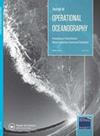气旋马迪对孟加拉湾的物理和生物地球化学响应研究
IF 2.4
3区 地球科学
Q4 METEOROLOGY & ATMOSPHERIC SCIENCES
引用次数: 6
摘要
马迪是2013年12月在孟加拉湾西南部形成的二级气旋风暴。它于12月6日形成低气压,到12月8日成为一场非常强烈的气旋风暴。马迪的一些独特特征是:(a)在向西北移动期间强度意外减弱,(b)在向西南方向突然改变路径近180度,以及(c)在向西南移动期间在冷核涡流上移动时在公海迅速消散。路径反转前强度的快速减弱主要是由于其经过冷核涡旋,由于涡旋从地下泵出冷水,上层海洋热含量减少。对涡旋反馈因子的分析再次表明,气旋移动速度较慢是由于冷核涡旋。当气旋进入冷核涡区后,在盛行东北风的影响下,气旋速度减慢并改变路径向西南方向移动。利用卫星遥感和Bio Argo数据估算的马迪湖生物地球化学响应显示,叶绿素-a (Chl-a)浓度从0.2 ~ 0.4 ~ 2.7 mg/m3增加,净初级生产力(NPP)从320 ~ 2500 mg C/m2 /d增加,分别是气旋前的7倍和8倍。CO2通量较气旋前的3.5 mmol/m2 /d增加了4倍,表明BoB在气旋马迪期间成为大气的强源。本文章由计算机程序翻译,如有差异,请以英文原文为准。
A study on the physical and biogeochemical responses of the Bay of Bengal due to cyclone Madi
ABSTRACT Madi was a category-2 cyclonic storm formed over the south-western Bay of Bengal (BoB) in December 2013. It formed on 6th December as a depression, and by 8th December it became a very severe cyclonic storm. Some unique features of Madi were: (a) an unexpected reduction in the intensity during its north-westward movement, (b) sudden change in track by almost 180o in a south-westerly direction, and (c) swift dissipation in the open ocean while moving over cold-core eddies during its south-westward movement. The rapid weakening in intensity before track reversal occurred mainly due to its passage over cold-core eddies, where the upper-ocean heat content was reduced due to eddy-pumping of cold water from the subsurface. An analysis of the eddy-feedback factor reiterated that the slower movement of the cyclone was due to the cold-core eddy. When the cyclone entered into the cold-core eddy region, it slowed-down and changed its track towards a south-westerly direction under the influence of prevailing north-easterly winds. The biogeochemical response of Madi estimated using the satellite remote sensing and Bio Argo data showed an increase in Chlorophyll-a (Chl-a) concentration from 0.2-0.4–2.7 mg/m3, while the net primary productivity (NPP) increased from 320 to 2500 mg C/m2 /day, both of which were about 7 and 8 times respectively higher than the before-cyclone values. The CO2 flux showed a 4 times increase from its pre-cyclone value of 3.5 mmol/m2 /day, indicating that BoB becomes a strong source to the atmosphere during the cyclone Madi period.
求助全文
通过发布文献求助,成功后即可免费获取论文全文。
去求助
来源期刊
CiteScore
7.50
自引率
9.70%
发文量
8
审稿时长
>12 weeks
期刊介绍:
The Journal of Operational Oceanography will publish papers which examine the role of oceanography in contributing to the fields of: Numerical Weather Prediction; Development of Climatologies; Implications of Ocean Change; Ocean and Climate Forecasting; Ocean Observing Technologies; Eutrophication; Climate Assessment; Shoreline Change; Marine and Sea State Prediction; Model Development and Validation; Coastal Flooding; Reducing Public Health Risks; Short-Range Ocean Forecasting; Forces on Structures; Ocean Policy; Protecting and Restoring Ecosystem health; Controlling and Mitigating Natural Hazards; Safe and Efficient Marine Operations

 求助内容:
求助内容: 应助结果提醒方式:
应助结果提醒方式:


